Thanks to the internet, researchers now have better tools to conduct both active and passive methods of research with less barriers than ever before. As adoption rates of mobile and the internet continue to increase at an unrelenting rate, conducting market research online makes for an ideal medium in terms of data collection. The world wide web is a great avenue for market research considering how it empowers users everywhere to freely share their thoughts and experiences, while researchers need only robust tools to take advantage of this trend and combine it with analytic skills in order to effectively collect and understand the available data.
The online qualitative processes practiced by market researchers include synchronous and asynchronous market research methods of data collection. We will be focusing on the asynchronous market research method where researchers use Market Research Online Communities or MROCs as well as online bulletin boards to conduct market research studies.
In this guide, we will discuss the use of online communities in market research and explore the following aspects:
- What are Market Research Online Communities (MROCs)?
- Uses of MROCs
- Difference of MROCs from Other Online Communities
- Types of Online Communities
- How do MROCs work?
- Pros and Cons of MROCs
- Online Communities vs. Focus Group Discussions
- The Value of Advanced Activity Options
- Importance of Online Community Analytics Tools
- Managing and Leveraging Online Communities
What are Market Research Online Communities?
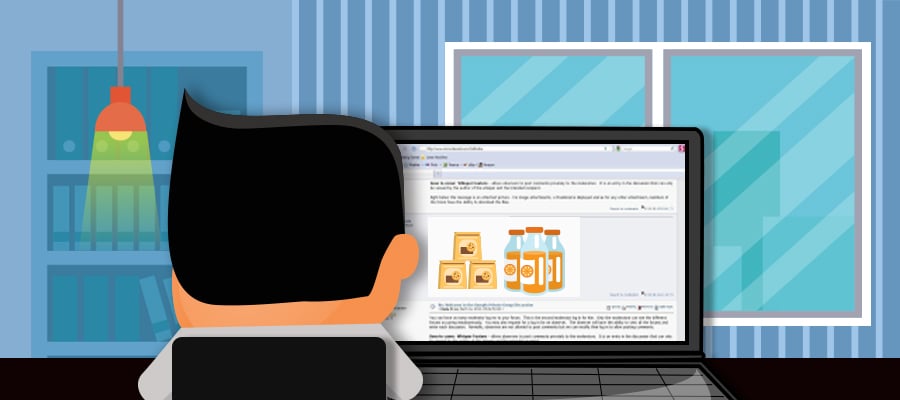
Market Research Online Communities (MROCs), also known as insight communities, are collectives of people that are grown or assembled online by a brand, service, or a market research service provider for the purpose of research. The use of MROCs is relatively new in terms of gathering qualitative insights online, primarily with the use of a social network or a private community platform or online bulletin board. These community members are guided to participate in a variety of discussions, activities, surveys and questionnaires provided by the company, brand, or researcher, geared toward a specific topic or campaign. Hosting MROCs for online market research is ideal for virtually any target demographic and provides researchers the necessary tools for both short and long term asynchronous qualitative insight gathering at a lower cost compared to other traditional methods.
Uses of MROCs

Generally, MROCs and online bulletin boards are used for strategic research projects or campaigns that may require a series of discussions over a period of time. MROCs may be established for one-off, continuous, or multi-phase projects where participants contribute their ideas and experiences through a dynamic flow of discourse over a specified period of time responding to questions and activities posed by the MROC moderator. The responses posted by the participants then paves way for researchers to efficiently identify the crucial opportunities and communication points that would enable a brand or service to connect or better resonate with the consumer.
Some uses of MROCs include:
- conceptualizing new product or service ideas
- positioning a new product or service offer
- tracking customer ideas and experiences
- figuring out the shortcomings or limitations of a low performing product or service
- identifying how to better resonate or appeal to a certain consumer base
While MROCs are typically used in researching consumer markets, organizations also communicate with MROCs when delving into B2B research. MROCs can provide B2B insights when it comes to:
- new service or product developments
- developing effective communication strategies for businesses
- discovering notable waterholes and other sources of information that influence industry decision-makers
- researching causes of shifts in the market and factors like regulatory or legislative changes, among many others
Market research online communities are ideal for gathering data because they are typically implemented with an easy-to-use and all-around very accessible online bulletin board platform for respondents. Participants can easily share their opinions and experiences while researchers are equipped with online market research tools for gathering and analyzing data effectively.
Difference of MROCs from Other Online Communities

MROCs differ from typical online communities in terms of their intended purpose. Obviously, MROCs are designed and cultivated for market research, while typical online communities and forums may simply exist as a way for a group of people to communicate and share information on specific topics of their own self-propelled interest.
In contrast to organic, niche-y communities online, Market Research Online Communities are specifically created and assembled to serve as a targeted way for organizations to communicate with consumers or other businesses for service support. Organizations or market research service providers conduct market research using online bulletin boards by building the online community through recruiting participants through various means - it can be through social media, print or website ads, online panels, market research recruiting agencies, and even direct-to-email campaigns to the target demographics. Members of MROCs are of course informed ahead of time of the purpose of the existence of the online community so that they can participate in an online bulletin board appropriately. Typical participants of MROCs are well-engaged consumers who choose to help a business or a brand improve their products or services.
MROCs are also different in that the participants often are asked to sign a release that says the content they are providing can be used in research. This is to protect both the study sponsor and the respondent, and to be sure the respondent is aware of how the data provided will be used in a research report. However, it is atypical to disclose the identity of a respondent to the study sponsor. Data is instead typically aggregated and no individual data is included in a study report that can be traced back to a specific respondent.
At the same time, it is sometimes required for a study participant to sign a non-disclosure agreement when participating in an MROC. This is because confidential data about a product’s performance, or confidential data about a product in development can often seep through in an MROC study. This protects the MROC sponsor while also making the respondent aware that they must understand that the material discussed in the MROC is for confidential use only and not for sharing.
A further difference between MROCs and other online communities is that respondents are most often paid for their participation. Payments, which are known as ‘incentives’ can range from a very small dollar amount, such as $25 for a one-day study, to several hundred dollars for a lengthy study. In addition, some payment are made in the form of points, which can be exchanged for the company’s products, or added up toward a gift card.
MROCs can also function without constant facilitation or moderation, given that the online community platform or bulletin board has various built-in activity and gamification options in order to maintain engagement.
Types of Online Communities
MROCs typically vary by the length of the study. As a marketing research services provider, we have so far observed two main types of market research online communities: short-term or ad hoc online communities, and long-term or continuous online communities. It is important for a researcher to determine the type of online community that aligns best with the organization’s time and financial budget in the project planning stage, in order to appropriately prepare the activities or tools that will be utilized as the study moves along.
Short-term or ad hoc online communities
These instant communities are built for a limited run that focuses on a short-term campaign or project. Maintaining a short-term community is also simpler and less complicated than its longer term counterpart. Short-term market research online communities would typically include up to 50 members at most per community. Respondent engagement typically runs from as short as one day, three days, or up to a week or two weeks, and has a finite end, by which time all of the activities would be fully completed by all of the participating respondents.
It is quicker and easier to set up a short-term community since the number of participants to recruit are fewer and is typically easier to populate, and there would be no need to look for new members every now and then, unlike when establishing continuous online communities.
Since there would be relatively less data in a short-term online community, it is therefore easier for researchers to check the integrity and quality of respondent participation when determining whether to pay the respondent the predetermined incentive following the close of the project. It may also be less expensive when financing short-term communities compared to continuous communities since it would only require short-term management in terms of staff and time. Fewer respondents may also mean less incentivization costs.
Short-term online communities are then disbanded upon meeting the set objectives and typically do not require follow-ups once the project has ended. However, the discussion board is left open for several weeks for the moderation to tag keywords and phrases and perform an analysis of the content generated.
Long-term or continuous online communities

Communities created for the long-term are for both continuous and intermittent studies that may tackle various and changing topics over a lengthy period. Long-term or continuous online communities for market research usually have a large member base, sometimes even reaching the thousands. Long-term studies can involve months or even years of correspondence, including continuous studies that may require the same set of respondents over the course of on-and-off projects over a period of time.
This kind of community may be more challenging to maintain because there are a lot of factors at play that must be managed over a long period. Participation and overall engagement may be fickle and in danger of dwindling significantly if not managed well. Some communities often require the same set of respondents on an on-and-off basis, and in this case the participants would be notified when there are new assignments or activities instead of having to maintain their engagement for a continuous period.
Because long-term communities take a lot of time and effort, organizations need to dedicate staff whose main role would be to maintain and oversee the community, which can add to the financial cost of the project.
Longer-term communities also incentivize the participants differently from short term communities. This is necessary because it would be difficult to get long-term engagement without periodic rewards for participation. Therefore, this is where point reward systems are often used. A point reward system allows the participant to accumulate points for work put into the community. Rewards are then earned for various point levels. Such rewards typically include gift cards or products mailed to the recipient, or vouchers for picking up products in a store.
How do MROCs work?
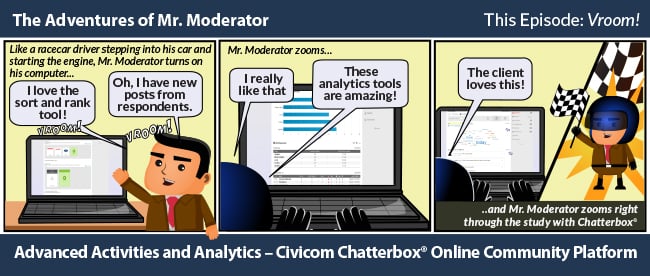
An MROC is established by inviting respondents based on a predetermined criteria for the study. The researcher then lays out a framework of how discussions will be conducted, including the activities and assignments to members of the community. What types of content would participants need to submit? Will there be a need for special privacy settings in discussions among members? This structuring will also help determine the tools that would be needed in collecting and analyzing the necessary data in achieving project objectives and uncovering insights. It is important to utilize a market research platform online with various activity and gamification options.
Over the course of a study, researchers guide and moderate as discussions take place. Respondents can freely contribute and submit content on a given topic to the community. While some projects may choose to implement privacy restrictions where some respondents may not see each other’s posts, community members are sometimes encouraged to interact with other participants by sharing and commenting on each other’s submitted content.
Pros and Cons of MROCs
Advantages of using MROCs

In comparison to other shorter-term qualitative research methods, the study process involving MROCs helps researchers gather more in-depth and reflective insight in a more flexible, convenient, and inexpensive way.
Since conducting research with MROCs is done asynchronously over the web, there are less constraints in terms of location and time. It is much more convenient to recruit respondents. It is well known that MROCs can foster collaborative engagement. The MROC method is also ideal in recruiting hard-to-reach or typically busy individuals or professionals that would otherwise have no time for traditional one-hour or two-hour focus group discussions. A typical example might be physicians who cannot attend focus groups or have difficulty setting a specific time for an in-depth research interview.
Additionally, project managers can assemble a member base as small or as large as needed based on the goal of the study. Assembling an MROC or conducting an online bulletin board study eliminates geographic barriers altogether, allowing people from all over the world to participate and weigh in on discussions. The project manager or administrator has control over selecting the appropriate participants in an MROC. This provides flexibility and can strengthen the integrity of the community which can reduce bias and lead to more natural or organic responses.
MROC respondents are encouraged to participate spontaneously in discussions and are armed with the ability to submit various types of content such as text, audio, photos, and videos, and each can complement or support each type of content in order to convey a clearer message. Participants may also be given the benefit of a disguise or some level of anonymity online. This can produce a more comfortable environment where respondents may feel encouraged in providing more honest and authentic feedback.
Since MROCs and online bulletin boards are asynchronous tools for research, participants are given ample time to answer without feeling rushed. Participants are given freedom to interact and reflect on their experiences or thoughts on a product or a service which ultimately leads to more in-depth discussions and insightful content.
Moreover, depending on the number of respondents and volume of data that can be accrued, MROCs can also allow for a quicker turnaround in completing a project. Administratively speaking, an MROC or online bulletin board study would also be easier to transcribe, archive, and can even be accessed in full for future reference.
Disadvantages of using MROCs
Using online communities or conducting online bulletin board studies does not work for every research situation. For one, online studies might exclude participants who have limited internet access. Non-tech savvy or technology averse individuals would not be successful in an online bulletin board community. It is also important to have an intuitive online bulletin board or research platform with excellent technical support readily available. Otherwise, recurring technical issues may deter usage and significantly affect participant engagement.
In addition, questions and discussions are typically designed and then led by the moderator, meaning that administrator or moderator bias might be at play and have some sway on the final results of the study. Moreover, although MROCs or online bulletin board studies are moderated, participants have all the freedom to contribute their thoughts and the flow of discussions can still be at risk for inappropriate or unsavory comments to all.
In terms of data gathering, MROCs still present a drawback despite enabling participants to contribute various kinds of content. For example, while video may capture some non-verbal responses, not every study would necessarily require individuals to submit this form of content, which means that there can still be non-verbal cues or emotions that may be missed.
Another con would be using incentives in market research online communities. As with other market research methods, some respondents might be compelled to answer what they think the researcher wants to hear, as they may perceive that a favorable response may lead to payment of an incentive bonus. An additional issue that may also arise is the unverifiable integrity of some responses and properly linking them to the actual, qualified respondents involved in the study, especially for text responses and still image or video contributions.
Online Communities vs. Focus Group Discussions
An obvious difference between online communities and focus group discussions is asynchronous versus real-time implementation, respectively. For online bulletin board studies, users are not required to respond all at the same time, and the study is conducted over a relatively longer period. Focus groups, on the other hand, would require instant feedback in a set time period.
The Value of Advanced Activity Options
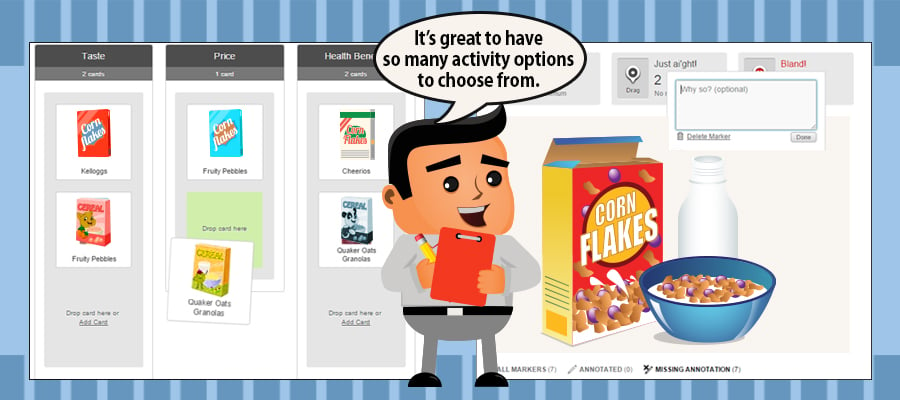
It is also important to have the right activity tools. If you don’t have a proprietary market research platform, it is a must to look for a feature-rich online bulletin board platform with all the right market research tools and activity options. Important features to look for in an MROC or online community platform include the basics, which are the ability to input text answers and upload photos and videos. Important other features to look for are the ability to do MROC polling, the ability to upload a file and the option to fill in blanks. Advanced features include the option to display a grid which lets you present a matrix of rows and columns for rapid evaluation of many items at once.
Another popular advanced feature is online community platform image review, which allows participants to markup and annotate precise locations of interest on any image you provide. Another very helpful and popular tool is the sort and rank tool, which allows you to place images on virtual cards which the participant can re-order and sort according to their preferences, in response to your questions on their points of view.
You can consult a market research online bulletin board provider in conducting an online community research study and customizing the online platform according to your needs. Are you in need of an affordable online bulletin board platform or a full-service online bulletin board? The most important thing is finding the right fit in discovering the insights you’re looking for.
Importance of Online Community Analytics Tools
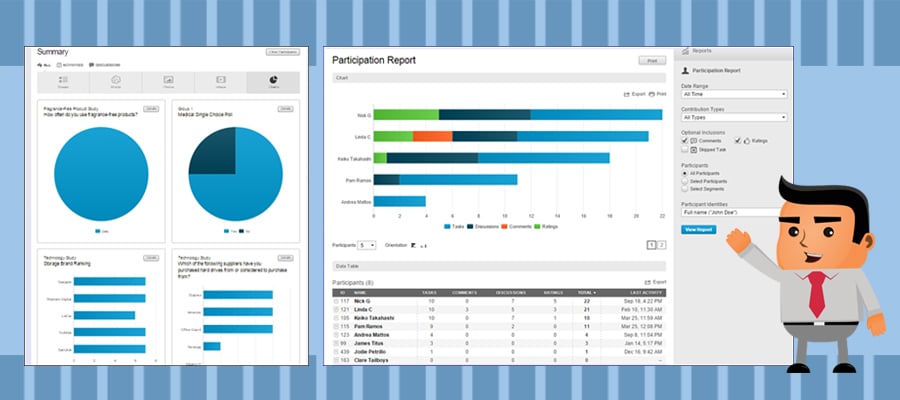
It is also vital that the full-service online bulletin board has robust MROC analytic tools that the researcher can further use when it comes to aggregating all the data and turning them into valuable insights.
Charts are a compact way to convey information and are very helpful because they provide a quick way for the audience to visualize what you are saying through illustrations with numbers. Charts can showcase trends that are up or down, as well as compare changes or relationships, bringing facts to visual life. Charts can be both forceful and convincing, and are useful to make a point very clear.
It is important to have a MROC platform that features data filters to show results that can be arranged per activities or per audience and which offers the freedom to choose either pie or bar charts that can be either horizontal or vertical.

Word clouds are a method for visually presenting text data. They are also referred to as a text cloud or tag cloud. They are popular for text analysis because they make it easy to spot word frequencies. The more frequent the work is used, the larger and bolder it is displayed. Word clouds can identify trends and patterns that would otherwise be unclear or difficult to see in a tabular format. They can be an effective method for analyzing text-data.
Word clouds are also a fun way to share open text survey responses. They can shed a surprisingly new light on what would otherwise be viewed as ‘ho-hum’ data. They are a great tool for communicating your most salient points. They’re perfect for calling attention to a common theme. They can dazzle your audience with what might be otherwise viewed as every-day, information. Not only are they attention grabbing, they’re also easy to use and inexpensive. But best of all, they are easy to understand and share.
Excerpt tools are useful when market researchers need to highlight words, quotes, phrases that stand out, need clarifications and expounding, and even those that raise questions. Civicom Chatterbox enables moderators to do such with the use of coded excerpts. It also allows you to design your codes – highlight quotes and tag them as good or bad, even neutral feedback and have a report of it generated.
One of the most challenging hurdles in completing a bulletin board project is getting your respondent actively involved. Bulletin board respondents can sometimes go inactive and be too intermittent in responding to tasks and activities. Thanks to participation reports generated from the platform, you’d be able to immediately identify who needs a little waking up and who finishes tasks in a timely manner.
Activity reports do the same. This type of report generates a bar graph of respondent completion and summarizes activities respondents have finished. This enables you to generate reports the filter responses per task and/or per respondent.
Managing and Leveraging Online Communities
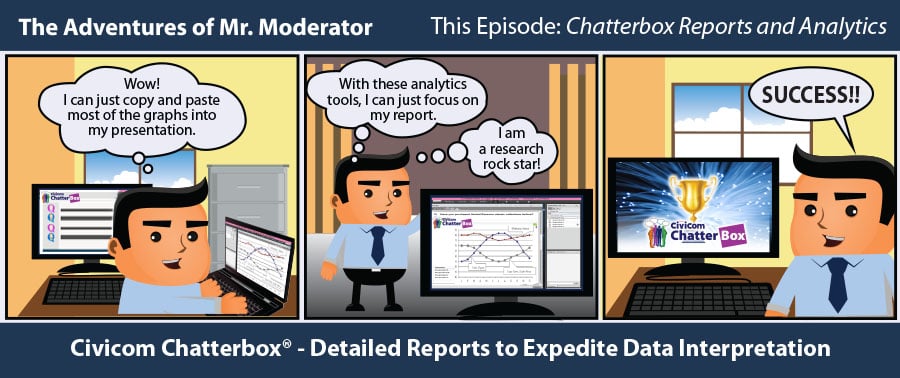
Now that you are equipped with the knowledge of how Market Research Online Communities work, you can now leverage the online asynchronous method to listen and understand to relevant consumers, and in turn, react and transform their thoughts into sound business decisions. In order to lead a study to its success, one of the most vital aspects to remember is engagement. MROCs or online bulletin board studies can only be successful when activities and discussions are actively implemented. Every conversation is an opportunity waiting to be transformed into valuable, actionable insight.




